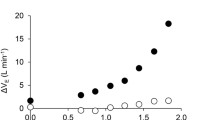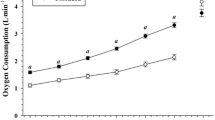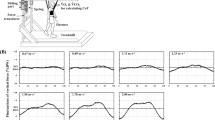Summary
Nine subjects walked on a treadmill with load weights equal to 10% and 40% of body weight carried on the back. Although the speed of the treadmill was selected so that the measured oxygen consumption (VO2) was the same for both load conditions, the heavier load placed an extra strain on the cardiopulmonary system and was perceived by all subjects as harder work than the lighter load. When the subjects worked at their own pace, walking on a level road or climbing stairs with load weights equal to 10% and 40% of body weight, they compensated for the heavier load by decreasing walking speed or climbing rate. Although the energy costs calculated from walking speed, body and load weight for self-paced walking and the external work of stair climbing were the same for both load conditions, the heavier load was again perceived as harder work. These findings are discussed as they relate to the definition of acceptable load weights.
Similar content being viewed by others
References
Borg, G.: Perceived exertion as an indicator of somatic stress. Scand J. Rehab. Med. 2, 92–98 (1970)
Bruce, R. A.: Exercise testing of patients with coronary heart disease. Principles and normal standards for evaluation. Ann. Clin. Res. 3, 323–332 (1971)
Cathcart, E. P., Richardson, D. T., Campbell, W. C.: The maximum load to be carried by the soldier. J. R. Army Med. Corps 40, 435–443, 41, 12–24, 87–98, 161–178 (1973)
Ekblom, B., Goldberg, A. N.: The influence of physical training and other factors on the subjective rating of perceived exertion. Acta Physiol. Scand. 83, 399–406 (1971)
Givoni, B., Goldman, R. F.: Predicting metabolic energy cost. J. Appl. Physiol 30, 429–433 (1971)
Hughes, A. L., Goldman, R. F.: Energy cost of hard work. J. Appl. Physiol. 29, 570–572 (1970)
Lind, A. R., McNicol, G. W.: Cardiovascular responses to holding and carrying weights by hand and shoulder harness. J. Appl. Physiol. 25, 261–267 (1968)
Lippold, O. C. J., Naylor, P. F. D.: The design of load carriage equipment for the soldier in battle order. A.O.R.G. Rep. 11/50. London: War Office 1950
Marshall, S. L. A.: The soldier's load and the mobility of a nation. Washington: The Combat Forces Press 1950
Pandolf, K. B., Givoni, B., Goldman, R. F.: Predicting energy expenditure with loads while standing or walking very slowly. J. Appl. Physiol. 43, 577–581 (1977)
Renbourn, E. T.: The knapsack and pack. An historical physiological study with particular reference to the British soldier. J. R. Army Med. Corps 100, 1–15, 77–88, 193–200 (1952)
Soule, R. G., Goldman, R. F.: Terrain coefficients for energy cost prediction. J. Appl. Physiol. 32, 706–708 (1972)
Soule, R. G., Pandolf, K. B., Goldman, R. F.: Energy expenditure of heavy load carriage. Ergonomics 21, 373–381 (1978)
Simonson, E.: Recovery and fatigue. In: Physiology of Work Capacity and Fatigue, ed. E. Simonson, pp. 440–458. Springfield: Thomas 1971
Wilmore, J. H., Davis, J. A., Norton, A. C.: An automated system for assessing metabolic and respiratory function during exercise. J. Appl. Physiol. 40, 619–624 (1976)
Author information
Authors and Affiliations
Rights and permissions
About this article
Cite this article
Myles, W.S., Saunders, P.L. The physiological cost of carrying light and heavy loads. Europ. J. Appl. Physiol. 42, 125–131 (1979). https://doi.org/10.1007/BF00421911
Accepted:
Issue Date:
DOI: https://doi.org/10.1007/BF00421911




